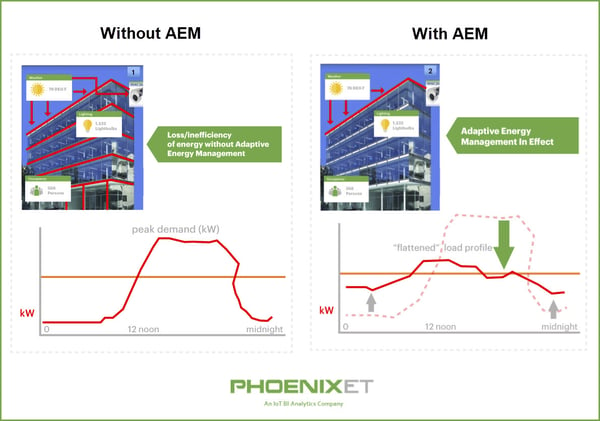Adaptive Energy Management — How to Use Your Buildings As A Battery
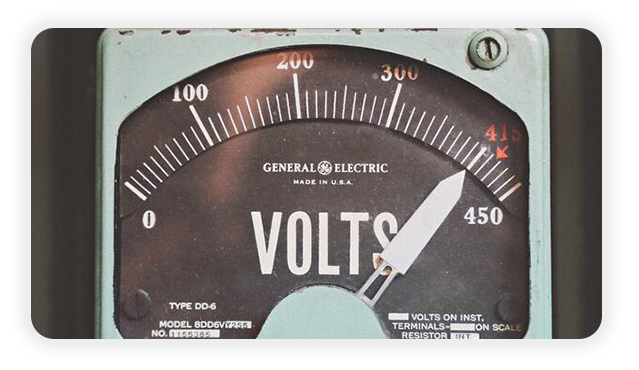
Facility managers are continually looking for ways to reduce energy usage — one that's better than just turning off lights. That's why Adaptive Energy Management (AEM) concepts are sometimes use: to reduce energy usage, save costs, and save the environment. This promising approach may help to keep buildings at comfortable temperatures, while reducing kW and costs.
With AEM systems, companies won't need to endure severe temperatures throughout the workday to save money. Instead, the building will simply regulate its temperature without any intervention by the people in it. In essence, Adaptive Energy Management lets buildings control their own climates.
To understand AEM, it is useful to take a step back and have an overview of what is physically happening within a building that can impact temperature.
This guide will outline:
- Climate Control Basics
- How Buildings are Engineered for Temperature
- Using Buildings as Batteries
- Adaptive Energy Management Applications
Climate Control Basics
Climate Control Uses the Most Energy
Electricity is the largest utility for retail and other commercial buildings, and most of that usage comes as a result of its energy systems. It takes a lot of energy to keep buildings feeling the appropriate temperature throughout every floor and area. Making sure employees and clients feel comfortable is a costly task, accounting for around 61% of commercial buildings' utility usage.
Reducing the amount of energy that commercial buildings use is the single most important strategy for reducing overall costs. And the benefits of AEM systems don't stop there.
With strategies like these, some buildings can store their own energy. Buildings with thermal capacity can become their own batteries by drawing and storing power from renewable resources, creating their own power supply. They can keep commercial buildings comfortable, while offering cost savings.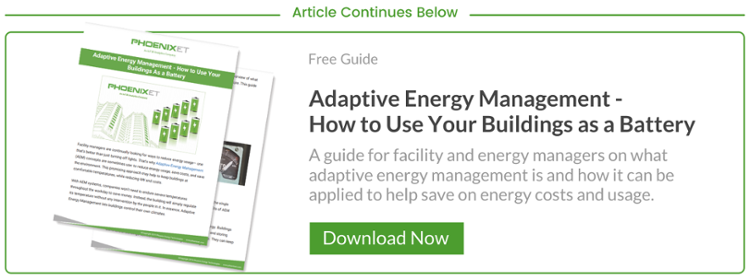
How Buildings are Engineered for Temperature
Buildings Are Balanced at 65 Degrees
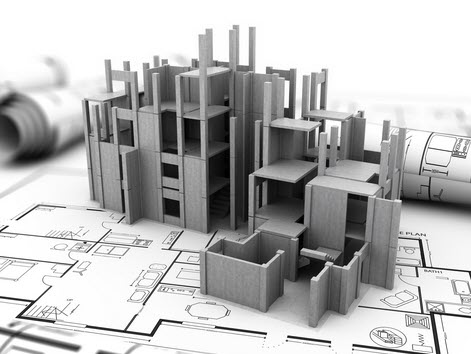
Efficiency is a strength. So if a company's literal building is inefficient, how can the company claim to be efficient? How can a company hope to lead its market if it can't keep itself efficient and strong?
Most buildings are designed to run at peak efficiency when it is 65 degrees outside. At 65 degrees, buildings use almost no electricity to control their internal climates. When it's 65 degrees outside, the building design is optimized, and the internal temperature will be a comfortable 72 degrees. There are several reasons this is the case.
The Shell Around a Building Adds 7 Extra Degrees
Most of the insulation that surrounds a room adds an extra 7 degrees. Adding to a building's temperature are such things as:
- The padding between the inner and outer walls of the building
- The walls themselves
- People within a room
Many people, in an effort to try to save on energy costs, attempt to set their systems to an unreasonable setpoint that the building isn't optimized for.
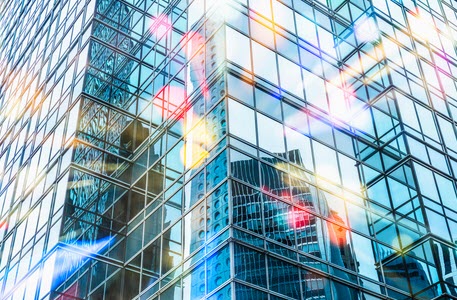
The building, it’s mechanical systems and control systems were designed to operate at a summer set-point of 72 degrees. That’s why thermostats come “out of the box” defaulted to a 72 degree set-point. People think “well if it takes a certain amount of energy to cool down the building to 72 degrees, all I have to do is raise the set-point to 76 degrees; and I’ll ‘save’ four degrees worth of energy”.
Except it’s not that simple. What usually happens is that they unknowingly set themselves up to spend additional energy, decrease comfort and increase “hot calls” - the number one complaint of building occupants. The reason is that the four degrees is huge.
Think of it this way. After a long hot weekend when the building has been sitting overnight at higher temperatures (of course they set the unoccupied temperature up to 80+ degrees, to save even MORE energy?!) The units turn on on Monday morning and have to overcome all of that excess heat.
Download our Adaptive Energy Management Guide
Unless it is a very small office or enclosed space, it’s going to take HOURS to get to a 72 degree set-point, if it can make it to that temperature during business hours. Because at the same time the units are trying to play “catch up” from the weekend, it’s getting hotter and hotter outside. Add in a “design day” scenario, where the building isn’t even designed to make the normal set-point and the system can never make it to the set-point.
BUT - and this very important; the RTUs never STOP trying to make set-point. They are all running at full stage cooling in futility. This basically guarantees no energy savings at all, and has also just set a new peak demand for the year, just by trying to set unreasonable set-points.
HVAC control systems are not always laid out to ensure accuracy and precision. Temperature monitors are often located in sub-optimal locations within the building. As a result, they may signal the need to be turned on when they don't actually need to activate.
The AEM approach is to change a building's setpoint according to many different variables. By adjusting the setpoint at which climate systems may activate based on the time of day and the weather outside, the building will run more efficiently.
Using Buildings as Batteries
When most people enter a new building, they notice the air feels different. It's recycled air, and it can be unhealthy. The air quality degrades more that it's reused, and for people to feel comfortable inside of buildings, they need to have new, fresh air moving through them continually.
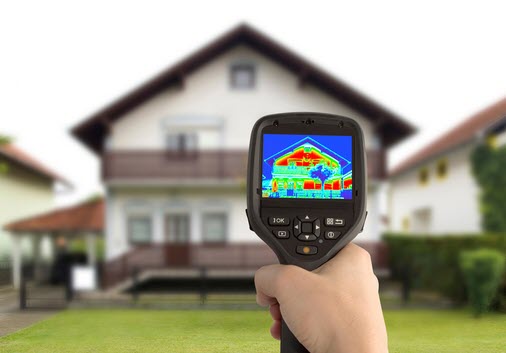
To ensure that buildings always get the fresh air they need to keep people comfortable, AEM programs can be designed so that the buildings use themselves as a battery. These systems fuse dormant systems, such as conventional HVAC systems and motion detectors, to keep air flowing through a building.
The energy to maintain a fresh, comfortable climate within a building comes from the building itself. The building's infrastructure absorbs cold air and then releases this when the building warms up. This concept is known as interior thermal mass. This "chain" of cold energy flow occurs through convection to conduction.
 Adaptive Energy Management Applications
Adaptive Energy Management Applications
Adaptive Energy Management looks for real energy solutions to replace the erroneous traditional way of thinking that putting building set points higher leads to lower energy bills and comes at the cost of comfort for those inside the building.
Adaptive Energy Management:
- Evens out energy demand curves
- Saves money
- Cuts down on energy required during peak hours, reducing peak charges
- Keeps occupants comfortable on hot days
Adaptive Energy Management Maintains Temperatures
AEM programs consider what the buildings need to run at peak efficiency. They account for inconsistencies and mistakes that most traditional energy systems make. AEM systems adapt to changes in the building, such as occupancy time, to ensure it runs at peak efficiency all the time.
AEM Programs Reduce Energy Demands
Every time people move rooms or the temperature outside shifts, the climate control systems turn on. This ends up costing the company money, since electricity isn't necessary to maintain a consistent temperature.
Instead, buildings can maintain consistent temperatures for the people in them by regulating climates in specific rooms. AEM programs can operate on a room-by-room system, instead of the whole building.
In the graphic below, the picture on the left demonstrates kilowatts used during the peak temperature of the day. The picture on the right demonstrates a re-shaping of the demand curve.
This curve on the right will change depending on the intensity of the heat load placed on it. The same temperature on a sunny day vs. a cloudy day will alter the heat load intensity, and therefore will impact the demand curve.
History of Adaptive Energy Management
AEM programs are the result of huge strides in technology and science. For example, it would be impossible to collect the information that AEM needs to function without the internet of things (IoT).
IoT allows energy systems to collect more nuanced information to make better decisions. Building automation technology, artificial intelligence, and other technologies enabled its development. New philosophies emphasizing corporate responsibility, including sustainability and energy reduction programs also spurred the systems' development.
It Makes People Happier And Costs Less
Companies want people in their buildings to be happy. Stepping into a commercial building should be an experience; it should leave an impression on everyone from the CEO to the janitor. In retail and other industries such as healthcare, customer comfort can affect sales and ratings - either positively or negatively.
Adaptive energy management programs can help you achieve your kWh, kW, or sustainability goals.
For more information on building management technologies, please download our Guide to Building Management Technologies.



